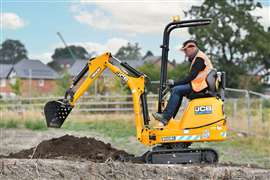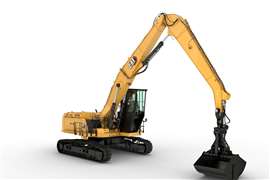Telematics: The data driving construction machines
31 March 2022
As more and more construction companies start using telematics to manage their fleets, Lucy Barnard finds out how monitoring data streams can drive down costs and carbon emissions and perhaps one day enable machines to operate themselves
David Milnes’ face lights up when he talks about data.
Fuel use data, carbon emissions data, down time data, even just which machines his company is hiring and where they are at the moment, could all be used to provide valuable information, says the head of digital construction at UK-based contractor BAM Nuttall, tapping his keyboard exuberantly.
“I think there is more and more recognition among contractors like BAM that data can provide insight that can aid decision making,” he says squinting at the multiple screens open in front of him. “If you don’t have all the data in one place then it’s difficult to see the full picture.”
Milnes is keen to get hold of as many numbers as possible from the many construction jobs in which his teams are involved so that BAM, the UK-based subsidiary of Netherlands based construction company Royal BAM, can start to think more strategically about the construction machinery it hires.
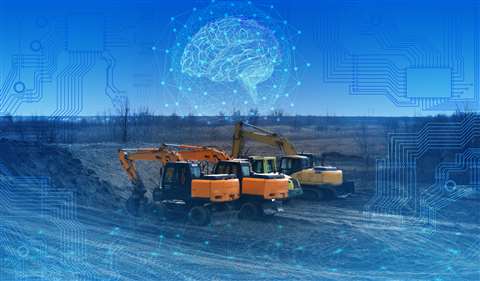 Telematics data can provide real-time information about a machine’s performance. Photo: Adobe Stock
Telematics data can provide real-time information about a machine’s performance. Photo: Adobe Stock
“We look at information such as plant type, location, routes travelled, hotspots of activity, revs and what time of day the plant is operating. All of which can help us monitor usage, effectiveness and down-time without any manual effort or the need to leave the office and see it with your own eyes,” says Milnes.
What is telematics data?
Most OEMs include sensors conveying real-time information as standard on new models of large construction machines. This telematics data is then made available for owners to download in order to keep track of the machine’s location, speed, fuel consumption and engine load amongst other things.
For rental companies, telematics can provide vital information about the exact whereabouts of their fleets and real-time information about safety and maintenance issues as well as whether it is being used correctly.
And for construction companies, the information can be used to keep tabs on all sorts of things, including carbon emissions, fuel consumption, operator behaviour and GPS tracking.
Jeff Drake, business area manager for machine control systems at US-based technology company, Trimble, often reminisces about the first time he saw his firm’s telematics system in action on a jobsite twenty years ago.
“In the early days, we put our system on a motor grader belonging to a contractor working on a residential grading project,” he remembers. “That contractor relied on an army of people who would go out and drive these wooden stakes or batters into the ground to mark it out. Then the machine would come in and destroy the batters and the guys would come back out and pound them all back into the ground again.
“I’ll never forget we were there late one afternoon, and this guy drove over on his motor grader and dropped the blade down onto a survey peg and the number on the peg matched exactly what was on the screen. And you could see that was the lightbulb moment for that contractor. It was now everywhere I go with this machine I have information that will help me do my job faster.”
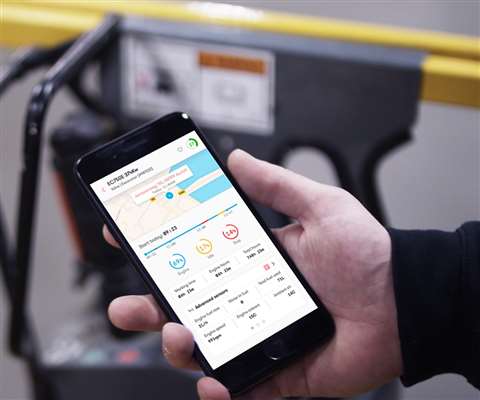 Trackunit’s Trackunit Go fleet tracking app allows users to monitor equipment from a phone. Photo: Trackunit
Trackunit’s Trackunit Go fleet tracking app allows users to monitor equipment from a phone. Photo: Trackunit
What telematics can tell you
As more construction firms start to see the benefits and telematics data becomes more easily available, tech experts say that its use in construction is becoming widespread.
“There is a general consensus in the industry that people don’t know what to do with the data when they get it. But I don’t think that that is the case anymore,” says Ryan Pike, market development manager at another off-highway telematics specialist, Denmark-headquartered Trackunit.
“Since the pandemic, large contractors are starting to understand what they want. It was a case of, ‘Oh my God we’re going to have to become compliant’ but now they are seeing it as a way of saving money and providing a lot more value.”
Pike adds that contractors are likely to find more and more value in telematics data.
“Every company these days has a big focus on emissions,” he says. “Contractors have to be able to demonstrate what emissions their sites are producing. At the moment they are very top-level calculations but soon people will start to delve further into the data. A healthy machine is going to produce X amount of emissions per hour but if the DPF is clogged and the machine is unhealthy then it could potentially produce more.
“Companies are starting to track with a real focus how much fuel their sites are using and how they can lower that amount for the foreseeable,” he adds. “On the surface you could track that through fuel bills but you could have one machine that is burning 20 litres an hour while actually that is because the operator is operating it incorrectly or they are keeping it running on their lunchbreak.”
Another issue is machine utilisation and how productive – or not – they are. “We’ve got 25 machines on our site and they are being used 25% of the day so I could take at least a quarter of those machines off site which will cost me less from a rental perspective and also cost me less from running them and maintenance,” says Pike.
However, for contractors, Milnes says, actually getting hold of the data and organising it, can be a daunting task.
Reports generated by telematics
“At an organisational level there is currently no one place for us to look at all our plant and understand how it is performing,” he says. “It’s just not practical at present to bring all of that data together in one place.”
The problem for contractors, Milnes says, comes with the fragmented nature of construction. At the moment, although the company has access to thousands of datapoints from all of the machines it hires to work on major projects, has no way of putting these together at a company, or sometimes even a project level.
“Plant suppliers often provide a telematics platform, sometimes free-of-charge and so when you hire the equipment, they give you login details for that and you can see the data provided,” Milnes says. “However, if you’re hiring equipment from more than one supplier then integrating the data can be difficult or time consuming so often it isn’t done.”
Moreover, he adds, although individual project managers will attempt to use telematics data to ensure the smooth running and success of his or her individual projects, the company has traditionally had no way of putting this information together on a broader corporate level.
And the problem is exacerbated by the company’s use of dozens of different software packages, with different project managers, clients and partners all favouring different tools.
“Rationalising the software we use is a challenge in itself,” says Milnes. “There is clearly no one software package that fulfils all of our needs and capabilities – and those of our clients – in a market leading way.
“We have to select a suite of tools at any point in time. Some of our projects are major joint ventures too which means technology stacks of more organisations need to be considered. This means that integrations are crucial. And people’s capabilities and preferences also come into it.”
Different data sources
Milnes says that how these integrations are managed is “the business opportunity of the future.” He expands on this, saying, “We don’t want to restrict innovation so there is a balance to be struck. I often get asked if we have a toolkit or a picklist of the software we use in the business or for how to identify new software to use. In fact, it is not as simple as that.
“We have a list of solutions in which we can provide experts or training but there is no specific toolkit to choose on every project. What needs to be done is to select the best combination of technology to suit the client and key stakeholders’ requirements on a project-by-project basis.”
 Telematics data which meets ISO standards can be used interoperably no matter what sort of machine they come from. Photo: Adobe Stock
Telematics data which meets ISO standards can be used interoperably no matter what sort of machine they come from. Photo: Adobe Stock
Pike goes even further. “You can have not only five different rental companies but each of those rental companies could have five different OEM manufactured machines. So, you can have different types of data coming from different types of machines that one rental company is trying to pull together.
“And then a contractor is trying to pull essentially five data points from five different rental companies. So, you’ve then got 25 different data streams coming through. You can imagine that it can get quite complicated.”
Pike says that a lot of the time people don’t use this data due to a lack of resource. “To shift your company focus from operations to supply both plant and data, you need to potentially employ people who are specialists in data and not in plant,” he says. “There’s a whole ecosystem in the background and I think large companies now are starting to deploy their own digital team to have a look at this. They are almost treating plant and the data that comes from the plant separately.”
He says that, although a lack of understanding about how to consolidate telematics information has been an issue in the construction industry for the past decade, data providers and telematics firms have been working to resolve it for almost as long.
The problem is that not only do different manufacturers produce data in different file formats, each with their own proprietary protocol, but also the data itself in the past has not always been comparable. Different manufacturers use different measures for things like fuel consumption while concepts such as idle time – the time when a machine is switched on but not doing anything productive – can be defined in completely different ways by different manufacturers. All of these things make it hard for end users to ensure that they are actually comparing apples with apples.
What are ISO standards?
Standardising all of this digital information into a consistent data set has been the work of the US-based Association of Equipment Management Professionals. It devised the AEMP Telematics Standard, setting out minimum requirements designed to make this sort of telematics data as interoperable as possible, which was first published by the International Organization for Standardization (ISO), an independent international voluntary standard-setting non-governmental organization headquartered in Geneva, Switzerland, in 2016. In 2020, the organisation published a 68-page revised and updated version of the standard, ISO 15143-3.
Essentially this means that, OEMs, telematics platforms and any other partners which are compliant with the standard agree to make around 30 pieces of information accessible to others through an agreed application programming interface (API) – a set of definitions and protocols for building and integrating application software.
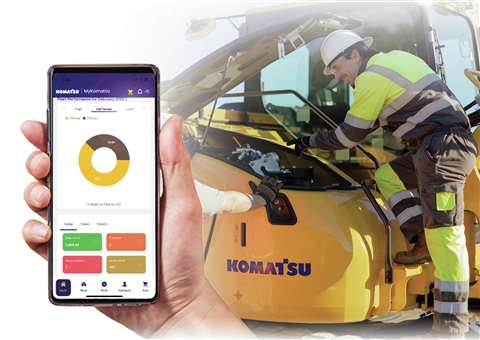 Komatsu’s My Komatsu app enables users to integrate telematics data from other OEMs too. Photo: Komatsu
Komatsu’s My Komatsu app enables users to integrate telematics data from other OEMs too. Photo: Komatsu
Tech companies including Trimble, Trackunit and TopCon are already offering solutions which integrate all data points meeting the ISO standard and most of the big equipment manufacturers are swiftly following suit.
In March Komatsu became the latest OEM to offer its customers a single digital hub, enabling customers to monitor other brands of equipment along with its own by entering their ISO 15143-3 API credentials.
“We understand that our customers are busy and expect technology to be easy to use,” says Matthew Beinlich, director of digital support solutions for Komatsu.
“Now, our customers can get the most important telematics data, such as location, hours, fuel consumption, idle ratio and production, from My Komatsu for many of the other brands of equipment they may operate.”
Although there is still work to be done to refine the ISO standard, Drake says that its adoption will lead to even more exciting opportunities opening up in the future for construction equipment.
He points to advances in other industries such as automotive or mining where autonomous vehicles are already being used on a regular basis. Tesla cars already come as standard with an autopilot function and the company is trialling self-driving software. Caterpillar has been manufacturing autonomous mining trucks for haulage since 2013.
“The next step will be when you have communication between machines,” he says. “When the machines themselves can start to talk to each other and ask questions. Am I working too close to something? Should I stop the machine? Should I throw up an alert? Should I call another machine over to finish this? That will start to happen. We’ll be developing unique functionality that goes on the machine around the jobsite and data to help support that. We believe that for this sort of data, that will be the next horizon.”
Back in his office, Milnes agrees. “As we move towards more autonomous plant, there is a question over how that can talk to each other and receive information about complex tasks such as what to excavate and when and what to off-load and where. Advances with basic plant have been made in mining, but it will be exciting to see that technology come to our construction sites.”
STAY CONNECTED



Receive the information you need when you need it through our world-leading magazines, newsletters and daily briefings.
CONNECT WITH THE TEAM










